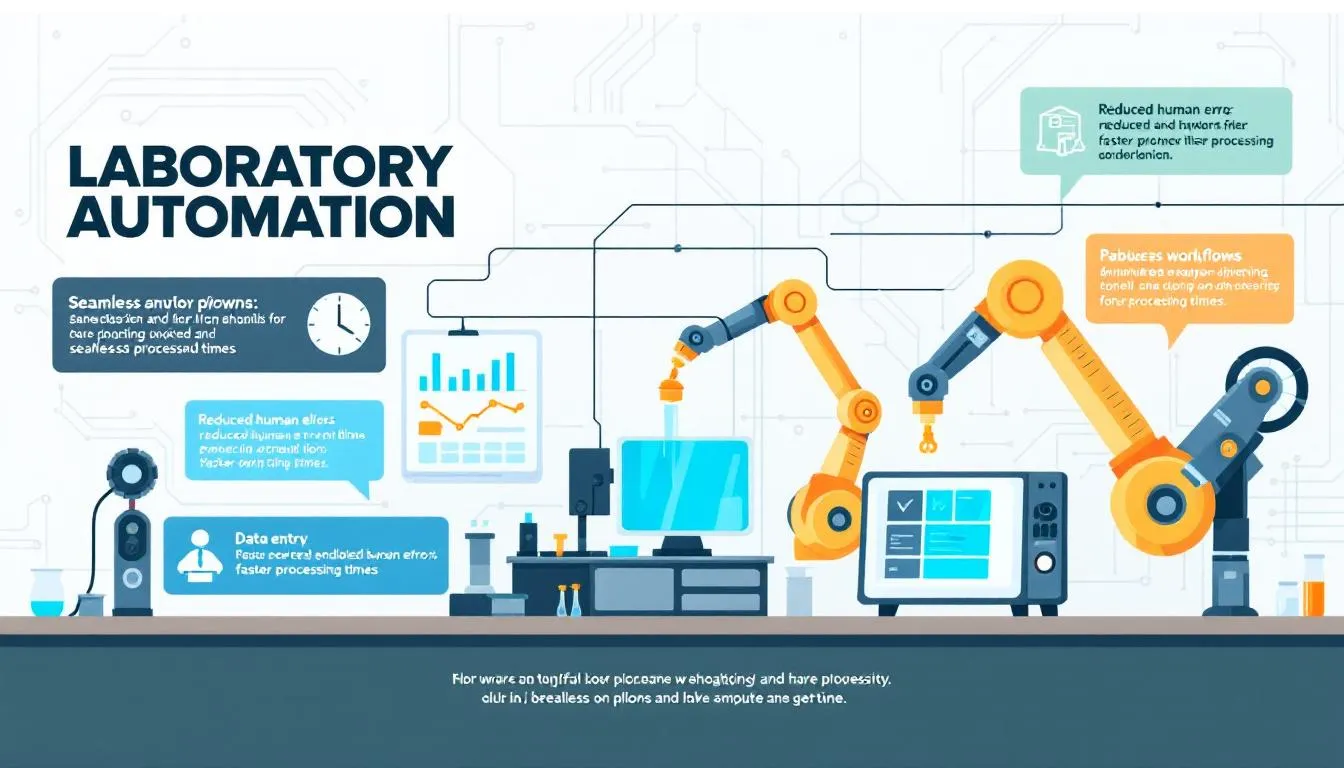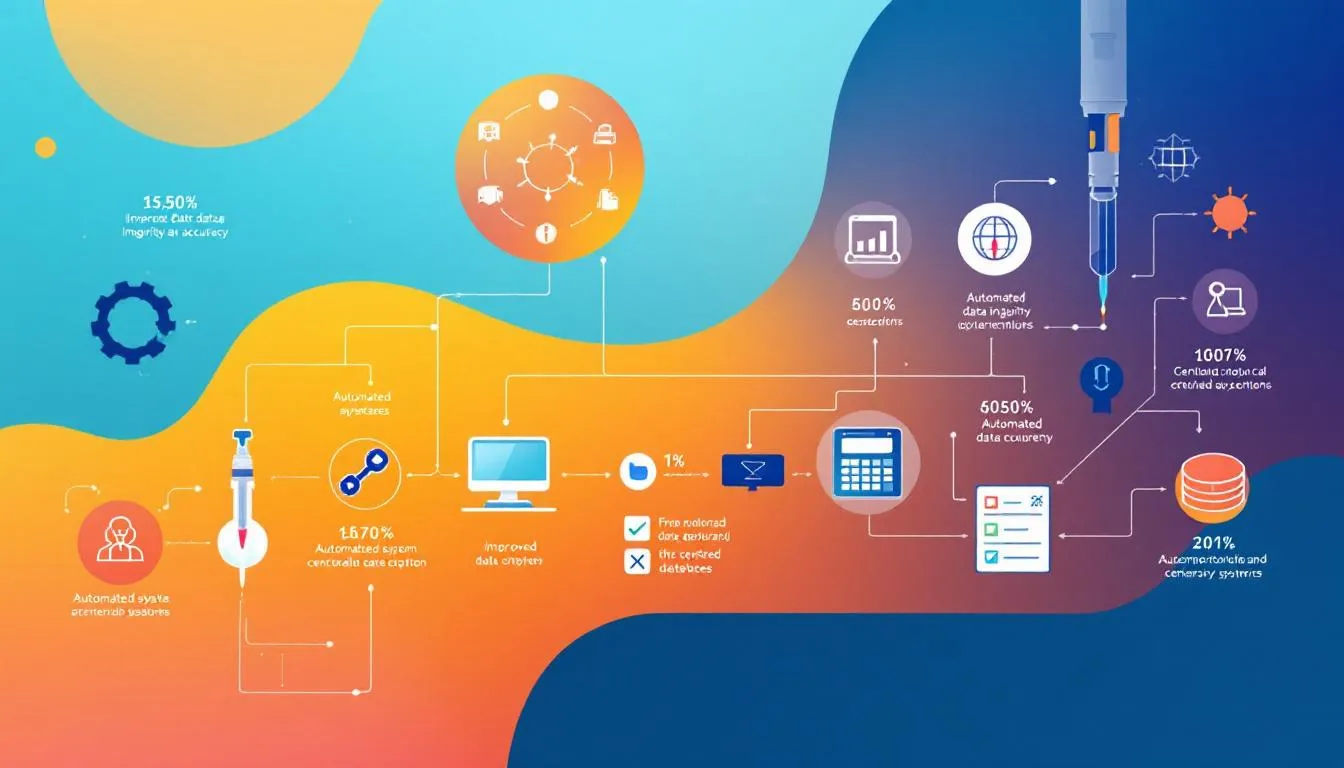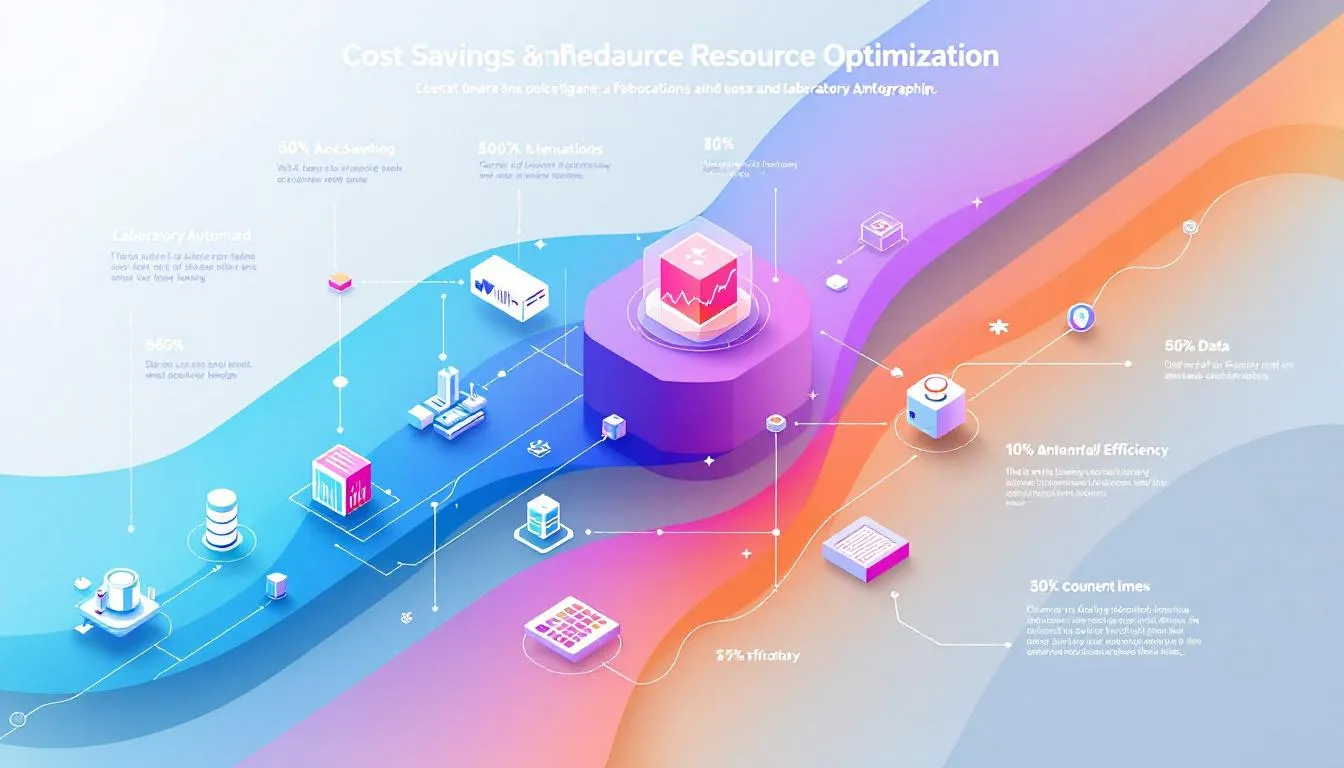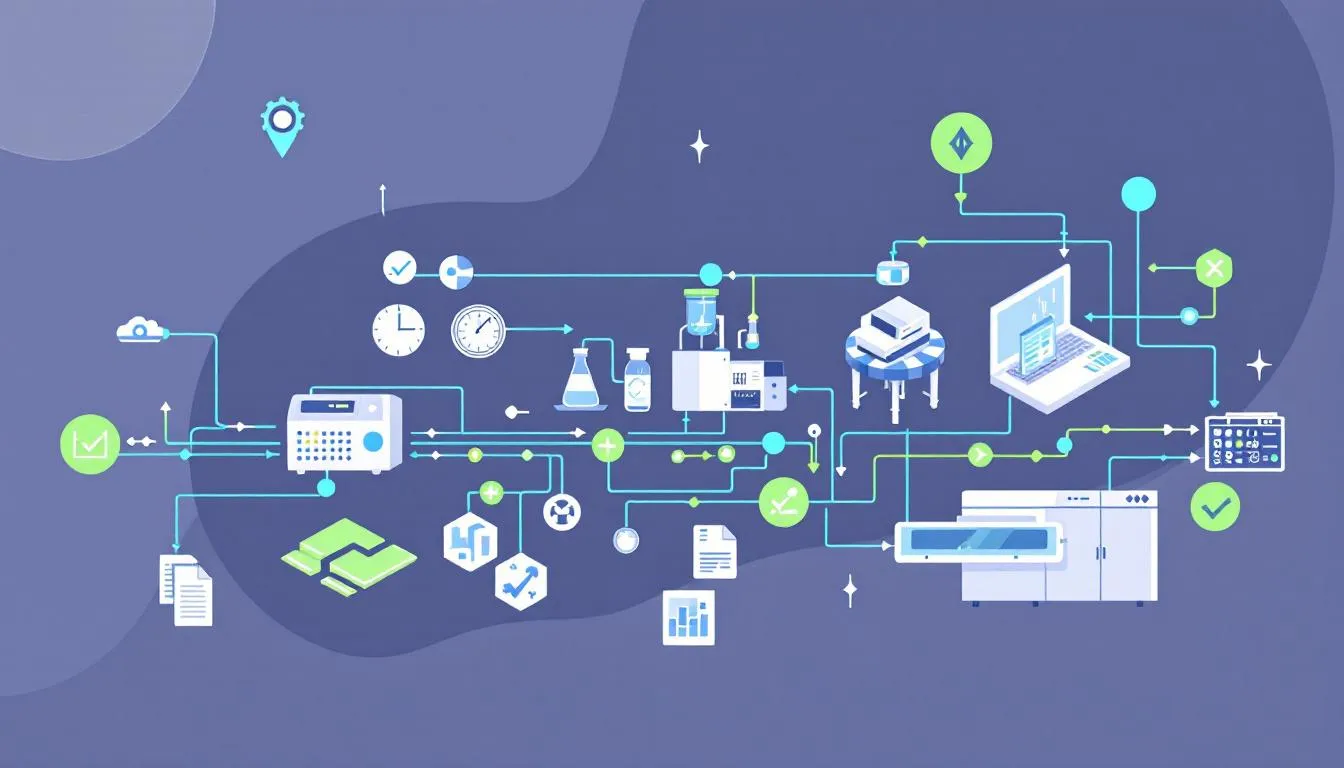Top Advantages of Laboratory Automation Systems
Are you curious about how laboratory automation can benefit your lab? Laboratory automation enhances efficiency, accuracy, cost savings, and safety. Dive in to explore the transformative advantages of laboratory automation in laboratory settings.
Key Takeaways
-
Laboratory automation enhances efficiency and productivity by reducing manual tasks, allowing scientists to focus on complex analyses and improving workflow.
-
Automation improves data integrity and accuracy through standardized procedures and real-time data capture, minimizing human error and ensuring reliable results.
-
Cost savings and resource optimization are significant benefits of automation, reducing operational costs and allowing better utilization of laboratory space and personnel.
Enhanced Efficiency and Productivity
Laboratory automation is a game-changer when it comes to enhancing efficiency and productivity. Automating repetitive tasks allows scientists to concentrate on more complex, high-value work, improving both outcomes and efficiency. With minimal supervision, automation systems manage laboratory tasks like sample handling, preparation, and analysis, greatly enhancing workflow efficiency to perform laboratory tasks. Additionally, automating these tasks enables lab scientists to dedicate more time to research and development, fostering innovation and progress.
Laboratory automation aims to enable staff to use their expertise more effectively, thereby improving quality, safety, and efficiency. Here’s how it streamlines laboratory workflows and increases throughput through automated workflows and laboratory workflow.
Streamlined Workflows
Automation reduces bottlenecks and ensures smooth operations from sample handling to data analysis. Automated systems handle tasks like sample preparation with precision, resulting in faster testing and less reagent use. For example, robotic systems can select and insert samples without human effort, minimizing the chances of error and improving specimen tracking. Automated workflows also contribute to a reduction in the materials used for each assay, minimizing waste and reducing operational costs.
Overall, laboratory automation transforms workflows by facilitating simultaneous preparation, labeling, and sorting of multiple samples efficiently. The integration of AI technologies further enhances process efficiency and data handling capabilities. Reducing manual intervention allows automated systems to create more efficient and reliable workflows. Automated workflows allow for continual operation outside normal working hours, facilitating scaling of operations as workflow demands change.
Increased Throughput
One of the most significant benefits of laboratory automation is the increased throughput it offers. These systems manage larger volumes of tests and samples efficiently, significantly boosting productivity. This improvement in testing volumes does not require additional staffing, enhancing overall laboratory efficiency. Automated laboratory systems can run continuously, allowing labs to process more samples than manual methods, further increasing throughput and operational capacity.
For instance, automated cell culture incubators allow for the accurate programming of various culture conditions while ensuring quality control in a clinical setting. Such advancements have shown to increase productivity and throughput by as much as 82% in laboratory tests.
Improved Data Integrity and Accuracy
Data integrity and accuracy are critical in laboratory operations, and laboratory automation plays a pivotal role in enhancing both. Automation minimizes human error in data recording and handling, ensuring consistent and reliable results. Automated systems use programmed workflows that significantly reduce variability and inconsistencies in lab processes.
The accuracy of data analysis is also enhanced with automated instruments, leading to more reliable laboratory testing findings in clinical labs and reduce errors, which ultimately saves materials and resources while minimizing human errors through precise measurements.
Let’s explore how standardized procedures and real-time data capture contribute to improving data integrity and accuracy.
Standardized Procedures
Standardized procedures enforced by automated systems greatly enhance reliability and data consistency. Consistent and accurate performance of routine tasks by these systems reduces variability in test results and improves data integrity. The reliability of laboratory operations is thus enhanced through the application of uniform measures in every task.
Real-time Data Capture
Real-time data capture in automation minimizes the risk of discrepancies or loss, ensuring immediate availability for analysis, enabling efficient data transfer. This capability makes the efficient data transfer and interpretation and identification of patterns within large database sets effortless, utilizing automated data capture and data entry.
Automated systems leverage advanced analytics tools to unveil trends and patterns within laboratory data, enhancing research outcomes and overall data integrity.
Cost Savings and Resource Optimization
Automation provides significant cost savings and optimizes resource use by enabling personnel to concentrate on higher-level tasks, reducing operational costs and improving efficiency. Integrating automated lab solutions meets the need for reduced operational costs and enhanced efficiency. Automated robots also reduce costs by increasing accuracy and minimizing waste.
The adoption of laboratory automation solutions has become more affordable over time, making it a viable investment for laboratories. Miniaturization techniques in automation cut material usage by lowering reagent consumption. Furthermore, LIMS integration optimizes clinical lab processes, enhancing resource utilization and operational efficiency. Adopting lab automation has also been shown to improve returns on investment (ROI) due to the maximization of throughput and efficient resource management.
Total laboratory automation can reduce pharmaceutical R&D costs by about 25%. Here’s how reduced manual labor and efficient space utilization contribute to these savings.
Reduced Manual Labor
Total laboratory automation redefines job roles of the laboratory workforce, allowing laboratory professionals to focus on high-value tasks and enhancing overall productivity. Reducing manual labor through automation cuts operational costs, including overtime, and lets operators focus on more critical tasks. Robotic solutions in labs can operate during non-working hours, increasing overall productivity and ensuring that laboratory operations continue seamlessly.
The reduction of repetitive manual labor leads to increased efficiency in the utilization of personnel and minimizes unnecessary labor costs through the elimination of manual processes.
Efficient Space Utilization
Automated technologies typically require a smaller footprint compared to traditional lab setups, optimizing laboratory layout and reducing overhead costs. Maximizing space efficiency enhances workflow and productivity in laboratories.
Space efficiency is crucial in laboratories to maximize productivity and minimize operational costs, making automation a valuable investment for cost efficiency.
Enhanced Safety and Working Conditions
Laboratory automation significantly enhances safety and working conditions for laboratory personnel by:
-
Limiting human exposure to pathogens and hazardous materials, ensuring a safer work environment.
-
Decreasing errors and preventing injuries related to repetitive tasks by minimizing them.
-
Incorporating safety mechanisms that prevent accidents, including safety limits that trigger alarms if exceeded. Automation systems improve safety measures by implementing robust safety features that can trigger warnings or automatically halt processes when safety limits are exceeded.
Let’s explore how handling hazardous materials and ergonomic benefits contribute to enhanced safety and working conditions in laboratories.
Handling Hazardous Materials
Liquid handling, a core function of laboratory automation, minimizes human contact with hazardous materials and helps to handle highly infectious materials. Staff might touch a specimen only once, and the automated liquid handling systems manage the rest of the process, thus enhancing safety during handling.
Automated systems effectively minimize human contact with infectious agents, ensuring safer laboratory operations with minimal human intervention through an automated system.
Ergonomic Benefits
By reducing repetitive tasks, laboratory automation helps prevent work-related musculoskeletal disorders. By reducing manual tasks and time consuming tasks, automation improves comfort and reduces fatigue for laboratory personnel and allows them to perform tasks more efficiently.
Automation improves laboratory ergonomics, promoting better physical well-being for staff.
Customizability and Scalability
Laboratory automation systems offer:
-
Extensive customizability and scalability, allowing laboratories to adapt to changing needs and future-proof their operations.
-
Customization and scaling options to meet the evolving requirements of laboratories.
-
Extensive configuration options.
-
Easy reconfiguration and upgrades with minimal downtime.
-
Seamless integration with existing processes, enhancing the overall efficiency of the laboratory automation system.
Labs can modify modules in their automation systems as needed, allowing efficient adaptability. Automation solutions can expand and adapt to changing demands, integrating smoothly with existing LIMS or custom hardware.
Let’s explore the benefits of modular systems and future-proofing in laboratory automation.
Modular Systems
Modular automation systems allow laboratories to start with essential components and progressively add more as needed. Modular components in lab automation enable labs to customize their total automation system for flexibility and scalability.
This method enables laboratories to adjust their existing equipment to evolving needs and expand capabilities over time.
Future-Proofing
Scalable systems ensure laboratories can adapt to evolving technologies effectively. They allow for easy upgrades and expansions as technology advances, enhancing efficiency and preparing labs for future challenges.
Scalable automation solutions help laboratories stay ahead of technological advancements and continuously improve operations by implementing an automation solution.
Improved Quality Control and Compliance
Laboratory automation significantly improves quality control and compliance by:
-
Standardizing processes and reducing errors from manual interventions.
-
Enforcing standardized procedures and documentation, which reduces data inconsistencies and improves test quality and accuracy.
-
Enhancing test precision and accuracy, leading to reproducible and compliant results.
These systems offer several advantages:
-
Trigger alarms or stop tests when safety limits are exceeded, enhancing safety.
-
Efficiently manage hazardous materials, ensuring a safe environment.
-
Help identify inefficiencies.
-
Accelerate sample processing times.
-
Reduce backlogs.
Let’s delve into how consistent quality assurance and regulatory compliance contribute to improved quality control and compliance in laboratories.
Consistent Quality Assurance
Consistent quality assurance is critical in laboratory automation to ensure accurate and reliable test results. Automation minimizes human error in data recording, ensuring consistent and accurate results across various laboratory processes. Automated systems enforce standardized procedures, enhancing data integrity and reliability in clinical laboratories through clinical laboratory automation.
Automated documentation and data management streamline regulatory compliance.
Regulatory Compliance
Automated solutions enhance regulatory compliance by:
-
Ensuring accurate data management
-
Integrating with LIMS to optimize data handling
-
Maintaining comprehensive records to support audits and regulatory compliance.
They streamline regulatory audits by making all data readily available.
Better Data Management and Reporting
Laboratory automation offers several key advantages:
-
Significantly improves data management and reporting.
-
Provides real-time monitoring and alerts to quickly identify deviations, enhancing reliability.
-
Offers real-time access to peer group data, enabling swift monitoring and response to quality control issues.
-
Integrates AI and ML to optimize data management, enhancing retrieval and analysis speed and accuracy.
Automation ensures efficient, accurate data management and proper information storage and retrieval. Implementing automation enhances automated processes and diagnostic procedures, leading to deeper insights and better research outcomes.
Let’s explore the benefits of integrating LIMS and advanced analytics in laboratory automation.
Integration with LIMS
Automated systems use laboratory information management systems to manage various data types, improving data flow and control between systems. Intelligent LIMS can integrate with various systems like LIS, ERPs, and CRMs to further automate laboratory operations.
Integrating automation solutions with robust LIMS maximizes the benefits of automation, ensuring comprehensive data management and reporting.
Advanced Analytics
AI and ML technologies improve data analysis and predictive analytics, driving informed decisions and innovative research. Automation enhances data management, enabling efficient storage, retrieval, and analysis of large datasets. These systems integrate seamlessly with LIMS, facilitating comprehensive data management and reporting.
These advancements, such as the adoption of electronic lab notebooks, lead to deeper insights into laboratory operations, improving research outcomes and contributing to scientific discovery.
Future Trends in Laboratory Automation
The future of laboratory automation is incredibly exciting, with emerging technologies like artificial intelligence (AI), machine learning (ML), robotics, and the Internet of Things (IoT) driving the evolution of lab automation. These cutting-edge technologies are poised to transform laboratory processes, making them more efficient, accurate, and scalable.
Laboratories with workforce shortages or high-volume testing benefit greatly from total automation. Advancing technology makes integrating AI, ML, robotics, and IoT increasingly essential, enhancing productivity, accuracy, and overall operations.
Artificial Intelligence and Machine Learning
Robotics, AI, and ML are advanced technologies integrated into laboratory automation. These technologies enhance data interpretation, pattern recognition, and predictive analytics in laboratory settings.
Integrating AI and ML enables better decision-making, supporting innovative research and discovery.
Robotics and IoT
Integrating robotics and IoT devices streamlines processes, boosting productivity and efficiency. IoT devices provide real-time monitoring and control, enhancing management flexibility.
Combining robotics and IoT facilitates remote operations, creating more efficient workflows and better outcomes.
Summary
In summary, laboratory automation offers numerous significant benefits, including enhanced efficiency and productivity, improved data integrity and accuracy, cost savings, and better safety and working conditions. Automation systems also provide customizability and scalability, ensuring laboratories can adapt to evolving technologies and future challenges. Improved quality control, compliance, and better data management and reporting are additional advantages of implementing automation solutions. As we look to the future, the integration of AI, ML, robotics, and IoT promises to further revolutionize laboratory operations, making them more efficient, accurate, and scalable. Embracing these advancements will undoubtedly pave the way for groundbreaking scientific discoveries and improved laboratory outcomes.
Frequently Asked Questions
What are the primary advantages of laboratory automation?
The primary advantages of laboratory automation include enhanced efficiency and productivity, improved data integrity and accuracy, and cost savings. Additionally, it ensures better safety, customizability, and compliance, leading to overall improved operational quality.
How does laboratory automation improve data integrity and accuracy?
Laboratory automation significantly enhances data integrity and accuracy by reducing human error and standardizing procedures, which leads to consistent and reliable results. This real-time data capture further minimizes variability, ensuring more trustworthy outcomes in lab processes.
What cost savings can be expected from implementing laboratory automation?
Implementing laboratory automation can yield significant cost savings by reducing manual labor and operational costs while optimizing resource utilization and decreasing material usage. Ultimately, this results in enhanced efficiency and overall cost effectiveness.
How does laboratory automation enhance safety and working conditions?
Laboratory automation significantly enhances safety and working conditions by minimizing human contact with hazardous materials and reducing the likelihood of errors and injuries associated with repetitive tasks. By incorporating safety mechanisms, automated systems create a safer and more ergonomic environment for laboratory personnel.
What future trends are shaping the field of laboratory automation?
The integration of AI, machine learning, robotics, and the Internet of Things is shaping the future of laboratory automation, enhancing efficiency, accuracy, and scalability in laboratory processes. Embracing these technologies will be essential for staying competitive in the field.
Share this
You May Also Like
These Related Stories

What is a Laboratory Information Management System?

Maximizing Efficiency with LIMS Reporting: A Practical Guide for Labs
.png)






No Comments Yet
Let us know what you think